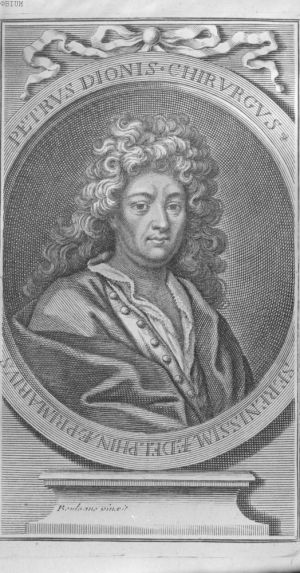A course of chirurgical operations, demonstrated in the Royal Garden at Paris / by Monsieur Dionis ... ; translated from the Paris edition.: Difference between revisions
No edit summary |
No edit summary |
||
| Line 3: | Line 3: | ||
You. make "'bold'" text like this. | You. make "'bold'" text like this. | ||
[[Pierre_Dionis_After_Boulogne.jpg|thumb|Engraving of Pierre Dionis published in his book, "Cours d'opération de chirurgie démontrées au Jardin Royal, Paris : L. d'Houry, 1707"|300px]] | [[File:Pierre_Dionis_After_Boulogne.jpg|thumb|Engraving of Pierre Dionis published in his book, "Cours d'opération de chirurgie démontrées au Jardin Royal, Paris : L. d'Houry, 1707"|300px]] | ||
Revision as of 04:02, 2 February 2024
You Make "italics" like this.
You. make "'bold'" text like this.

Introduction
The book “A course of chirurgical operations, demonstrated in the Royal Garden at Paris/ translated from the Paris edition” was a transformational medical text book written at the cusp of the transition from medieval to modern day surgical medicine. The original book was written by French author and surgeon Pierre Dionis in 1707. This book would go on to become very popular and went through many editions and translations, allowing it to be shared internationally. The book provides a detailed description of ___ surgeries that Monsieur Dionis demonstrated at the Jardin Royal in Paris. It is well organized with each chapter talking about a certain condition, its treatment, and a full description of how to perform the surgery including images of the tools and anatomical modifications done. He wrote the book in order to spread the knowledge of these specific surgical techniques all over France and eventually the world. He wanted to improve the general state of medicine and quality of medical care all over Europe.
This specific copy is “A course of chirurgical operations, demonstrated in the Royal Garden at Paris / by Monsieur Dionis ... ; translated from the Paris edition” the English translation of the second edition of the Dionis’s book and was published in London in 1733 by publisher J. Tonson. It can be found in Kislak Center for Special Collections, Rare Books, and Manuscripts. This textbook would go on to transform surgical practices all over Europe and set the foundation for the modern state of surgery.
subsection 1.a
Historical Context
Material Features
Substrate
Format
This book is structured as a codex with an octavo format which means that it is assembled with multiples of 8 pages per gathering. is smaller than folio so this could mean that it is cheaper and more accessible than folio books. Another potential benefit of the smaller format is that it is easier for surgeons to carry and use a more compact book in the surgery room than a bulkier folio book.
Binding
_____
Book Structure and Content Analysis
Paratext
Preface
The preface is a direct translation of the original preface written by Pierre Dionis (it is not something that the translator added). It gives background about the author, the importance of surgical teaching, and describes the organizational structure of the information presented in the book. He emphasizes the importance of science and medicine and strongly advocates for people to be exposed to this knowledge. It seems like the primary audience of the include doctors, surgeons, and medical students during the time period, but anyone that is interested in this information could also read it. The preface also explains the structure of the book, talking about how each chapter is a unique demonstrations that he did, and he is writing about is so that people who didn't witness the procedure can learn about them.
Index
At the end of the book, there is a section called “An alphabetical Table” which is basically an index. This was created by Pierre Dionis, not the translator.
Significance of Preface and Index
Marginalia
There doesn’t seem to be any handwritten marginalia in the book (except for the ownership mark on the title page) but there are lots of printed marginalia. Since the author included it, it could technically count as paratext. The printed marginalia seems to give quick descriptions of what the paragraph talks about; they kind of act like like chapter subheadings that break down the chapters content. Monsieur Dionis likely included the printed marginalia in order to make sure the readers could absorb the most pertinent information and gain the most from the textbook. The printed marginalia could help clarify complex medical topics, guide the reader towards the key points, and reinforce crucial information, among many other benefits.